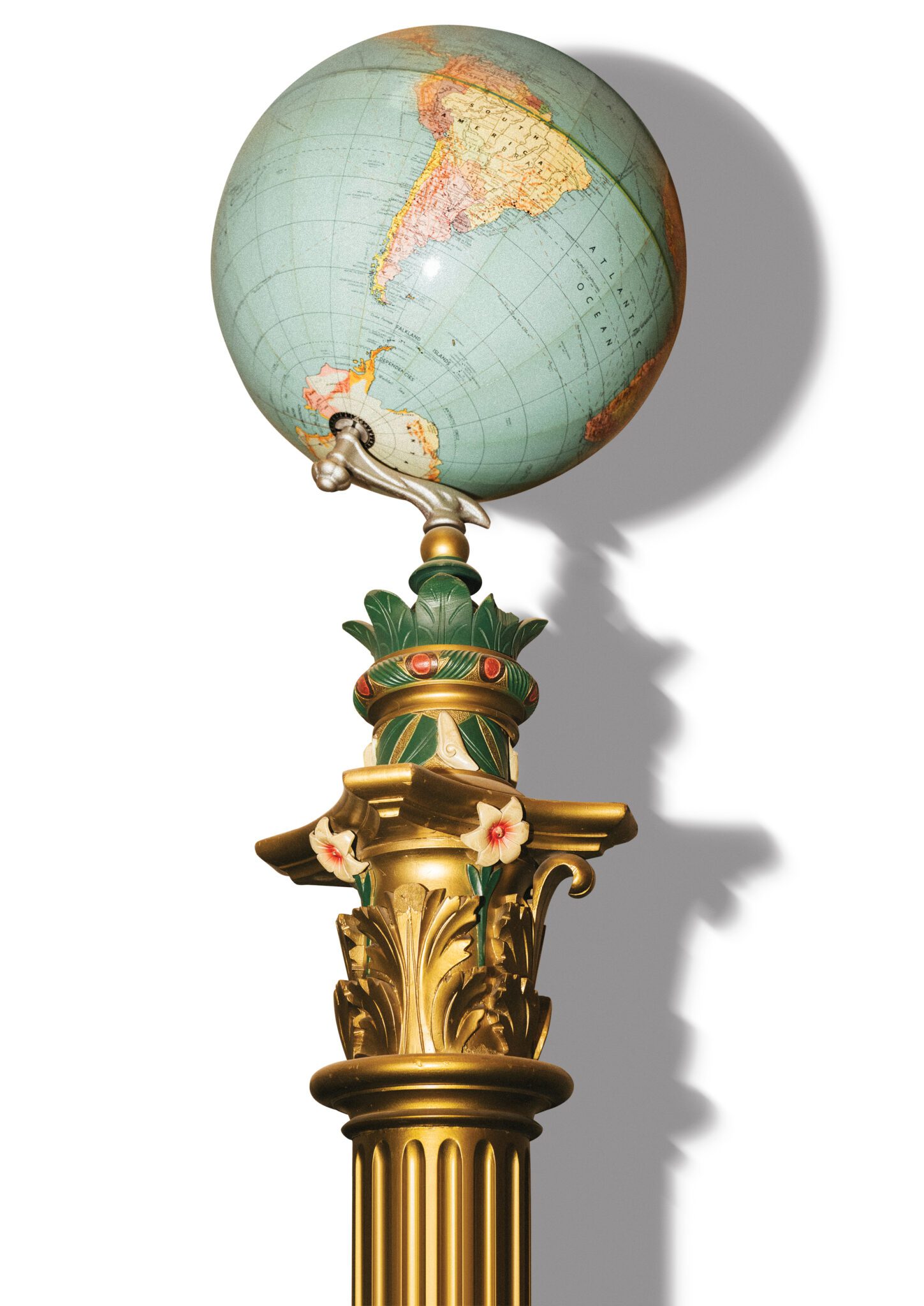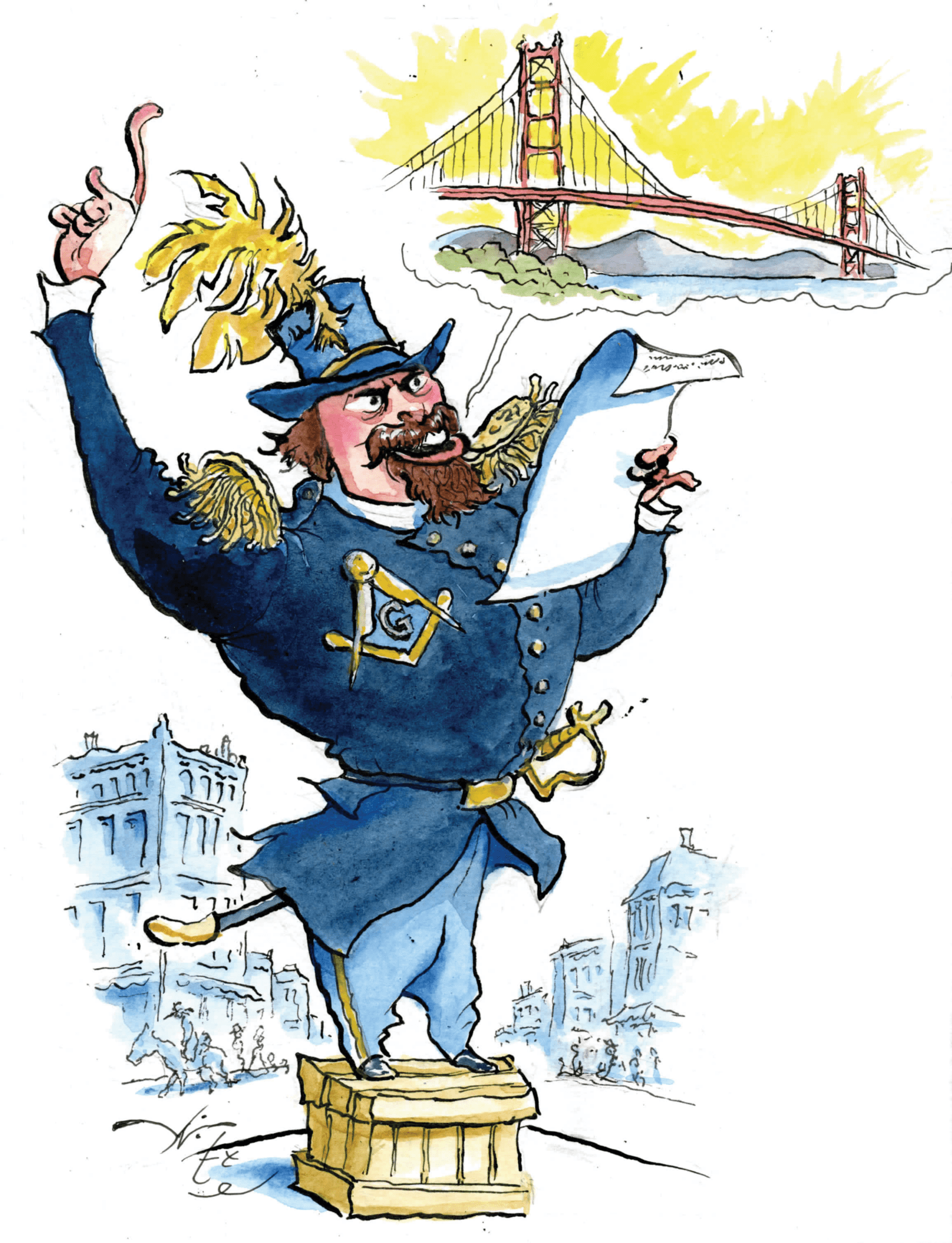
The Famous Masonic ‘Traveling Trowel Train’ to Mexico of 1909
In 1909, a special delegation of California Masons set for Mexico City to deliver a world-famous Masonic traveling “Unity” trowel.
Federico Jimenez will never forget his first experience in a Masonic lodge room. It was the early 1950s, in Aguascalientes, Mexico. Over dinner, he found himself seated beside the governor of the state. Rather than lord over the banquet, however, the governor served Jimenez—along with all the rest of the ranchers and tradesmen there. “They said, ‘In here, everybody is equal,’” Jimenez, now 92, recalls.
Years later, Jimenez was still moved by that memory. So after he immigrated to California, he sought out the local Masons. As it turned out, he had friends with connections to a Spanish-speaking lodge in L.A. His friend could even serve as his padrino, or reference. And in 1969, despite speaking very little English, Jimenez reached out. Half a century later, he’s still an integral part of the lodge.
That’s a fairly common story at California’s two Spanish-language lodges. At Maya № 793 and Panamericana № 513, both in Los Angeles, members with ties to Mexico, Central America, the Caribbean, and South America have created a special niche within California Masonry. Members there are able to celebrate and emphasize their heritage, reconnect with family customs, and keep traditions alive. Whether it’s recent immigrants or folks who’ve been in the United States for generations, the two lodges offer something that can be found nowhere else: a Masonic familia. “The minute I came into the lodge, I felt like I was at home with my family,” says Christian Sermeno, master of Panamericana № 513. “When I’m there, I feel like I’m surrounded by all my tíos.”
It isn’t just the language that sets California’s Spanish-speaking lodges apart. Members there have built on Masonic traditions from a wide range of countries. The result is a unique blend of cultural and fraternal customs that’s unique to California but representative of the lodge members’ diversity.
“It’s very spirited, very loud, and very fun,” says Edguin Castellanos, a past master of Panamericana № 513 who was born in Belize. “That can be a turnoff for some people, but we’re from Latino homes. That’s part of who we are. That’s what I fell in love with, that rich spirit.”
The connection transcends individual nationalities. More than half of the two lodges’ membership was born outside the United States. Among the countries represented there are Mexico, El Salvador, Guatemala, Bolivia, Peru, Cuba, and Chile. For many, Freemasonry has been a way to establish social connections in a new country. It’s also a bridge back home, to family and friends in the fraternity abroad. That bond is often deeply personal. Sermeno, for instance, first joined Vista № 687, north of San Diego. As he progressed through the degrees, however, he sought a way to follow in the footsteps of his grandfather, who’d been a lodge master in El Salvador. Joining Panamericana № 513 and learning the ritual in Spanish was a way to feel closer to him.
Those family ties are a source of immense pride for many. When Oliver Alejandro Torrealba Torres was raised in Yolo № 195 in Davis, a contingent from Maya № 793, where his father belongs, made the trip north to support him. In a nod to his family’s Venezuelan heritage, his degree was scheduled for June 24—that country’s independence day (and also the feast day of St. John the Baptist). The significance of the date wasn’t lost on him.
Then there’s the simple matter of being around familiar faces. “There isn’t a very big contingent of Latinos in California Masonry,” says Edwin Torres, a charter member of Panamericana № 513. “For the most part, these are the only lodges where, as Latinos, we see people who look like us.”
Above:
Members of Panamericana No. 513 form a chain of unity. The lodge is one of two official Spanish-speaking lodges in California. Photo by Matthew Reamer.
Establishing that home away from home has been the project of generations. In the early 1950s, the Grand Lodge of California for the first time assigned a special committee to scout for interest in forming a Spanish-speaking lodge, to complement the state’s existing French-, German-, and Italian-speaking lodges. However, the issue proved contentious. Many within the fraternity argued against expanding foreign-language lodges, on the basis that they divided members along ethnic lines. In 1957, an affinity club led by the late Aurelio Gallegos of Covenant № 527 requested permission to form a Spanish-speaking lodge. The request was denied.
Gallegos and company were undeterred. And in 1959, the group did successfully charter a new lodge, Maya № 793. The lodge was not allowed to work in Spanish, which was still banned by the California Masonic Code. Regardless, it became the first lodge under the Grand Lodge of California to be specifically geared toward Latinos.
The idea proved popular. From an original membership of 54, Maya № 793 grew rapidly. In its first decade, the rolls doubled in size. By 1975, that necessitated a move to a larger meeting space, and the lodge purchased a hall in Monterey Park. By 1983, the lodge had reached a high of 189 members.
Importantly, it also took on an informal ambassadorship role in Latin America. In 1982, its past master, Alejandro Navarro, served as the grand master’s representative at the National Masonic Congress, held in Mexico. The lodge became a regular guest of its counterparts across the border. “It was really impressive,” Jimenez remembers. “We had a good relationship with the lodges in Mexicali and Baja. Every seat in the lodge room was taken.”
Despite the lodge’s success, it wasn’t until 1992 that it finally fulfilled its founders’ hopes. Forty years after the matter had been voted down, Gallegos again introduced legislation to allow Maya Lodge to recite the degrees in Spanish. Evidently, attitudes had changed in the intervening years. It passed.
Today, Maya is officially a bilingual lodge. Regular meetings are held in English, but candidates choose whether to receive the degrees in English or Span-ish. Ritual “teams” proficient in each language step in when called upon, so not every officer needs to be word-perfect in both.
At Panamericana № 513, the approach is more straightforward, at least linguistically. Like Maya, Panamericana grew out of a club of Spanish-speaking Masons. That group formed in Granada Hills in 2000. Using the Spanish ritual translated at Maya, the group began training a new cohort in a version of the craft that hews more closely to what’s practiced in most of Latin America. “We felt there was a void in some ways in California Masonry—a cultural void,” Torres says.
Panamericana’s founders envisioned an all-enveloping Latino Masonic experience. Not only would the ritual be performed in Spanish, but so would all meetings. The lodge would also embrace more of the esotericism found in Latin American lodge rooms. “The idea was, let’s create a place where we can have an above-and-beyond experience specifically for members who share this background,” Torres says.
These days, Panamericana № 513 is also a “traditional observance” lodge. Members wear a suit and tie to meetings, place extra emphasis on their ritual performance, and host frequent lectures and symposia. Initiates are expected to produce research papers demonstrating a deep understanding of Masonic philosophy. “It’s pretty intense,” Torres acknowledges with a laugh. “But it’s a labor of love, man. We have a lot of pride in this lodge, and it’s aligned with our pride as Latinos.”
Often, members of the two Spanish-speaking lodges enter with a long history in Freemasonry. Oscar Gomora, for instance, is one of several members of Panamericana № 513 who originally joined an “irregular” Spanish-speaking lodge (those not recognized by the Grand Lodge of California). Only later did he discover that the Grand Lodge of California included Spanish-speaking lodges. Now, he says, he appreciates the organization and support that the larger fraternity offers.
Past master Sergio Soto also joined Panamericana from an irregular lodge, where he says most members were unaware of matters of “regularity.” In any case, he says, there’s clearly an appetite for Masonry among Latinos in California—and one that should be better catered to. “I think it’s about time that California Masonry takes a look at the Latino community,” he says. “Having lodges that are visible in Latino communities will help us get new members and be a way for people to come into the Grand Lodge of California.”
Above:
Panamericana No. 513 was started as a Spanish-speaking club of Masons in Grenada Hills. In 2005, it was chartered as the Grand Lodge of California’s first 100 percent Spanish-speaking lodge. Photo by Matthew Reamer.
Improving its visibility in the community is Panamericana’s biggest goal, members say. When the lodge was first chartered, it was with the intention that it would serve as a temporary home for recent immigrants looking to join the fraternity, before they settled in elsewhere. There was talk of offering English as a second language courses. Those never quite materialized. But increasingly, the lodge is becoming a resource for recent arrivals.
Between scholarships for local students, a yearly backpack and school-supply drive, and book give-aways, the lodge has made itself known as a place where immigrant families can turn for help. More and more, members say they’re approached by people seeking asylum or in need of other forms of assistance, many of whom come with connections to Masonry back home. While there’s no formal assistance program in place, the lodge has become adept at connecting those in need with much-needed information and services.
Torres says that this work is helping the lodge become a “beacon” in the community. “We’re like this local incubator where people can come in and talk to someone who can point them in the right direction,” he says. “It’s all very word-of-mouth, very community-focused.” That’s the next step in the evolution of California’s Spanish-language lodges, members say.
More than 50 years after opening their doors, Castellanos is direct in his view of where Maya’s and Panamericana’s future potential lies. “In my opinion, a hub for immigrant brothers to come in and find help is exactly what they should be. We’re a place they can call home.”
Above:
Past master Sergio Soto of Panamericana No. 513 waves the Mexican flag during a Cinco de Mayo celebration. Photo by Matthew Reamer.
PHOTOGRAPHY BY
Matthew Reamer

In 1909, a special delegation of California Masons set for Mexico City to deliver a world-famous Masonic traveling “Unity” trowel.

From Mexico to Argentina, Latin American countries embody a wide range of Masonic rituals, from the familiar to the highly esoteric.

150 years after he first proposed the San Francisco Bay Bridge, the legendary eccentric and Freemason Emperor Norton may finally get his due.